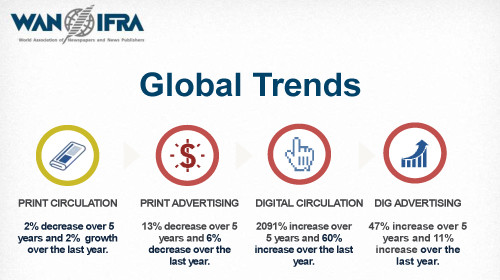
While more money is still being made globally through advertising revenues than through circulation, audiences are increasingly becoming more likely to pay for content. Mobile is heavily responsible for that increase, according to Ben Shaw, director of global advisory at the World Association of Newspapers and News Publishers (WAN-IFRA).
At last week's Key Executives Mega-Conference in Atlanta, Shaw said he believes this balance will begin to even out as people become more accepting of paying for online subscriptions. "I think that mobile has a really strong play there, as well as in attracting those paid circulations," he said.
Mobile and video are the main drivers in the growth of global ad spending, Shaw said, especially as smartphone usage increases across the globe.
"This has a lot of implications in developing countries – in the media industry – in that a lot of places are going straight from print to mobile publishing strategies," he said.
But, the rapid growth of mobile does not make up for the losses in print, he said. "For every dollar we're making in digital, seven are being lost in print."
Transitioning from print advertising to digital is challenging due to overall unpredictability from competitors to customers, he said. "It's rare for any company in any industry to maintain a competitive advantage for any length of time," he said.
In today's world, Shaw said competitive advantages evaporate almost yearly. Companies can't afford to spend months at a time crafting a single long-term strategy. Instead, he said newspapers need to build multiple strategic initiatives into their plans – and launch one initiative after another, exploiting many transient competitive advantages at once.
No one form of advertising will be the breadwinner for your company, he said. Instead, it's going to require a "logical and methodical pipeline of lots of good smaller ideas that are going to keep revenue growing."
He cited a case study from Aftonbladet in Sweden, which is targeting viewers' needs by setting five deadlines throughout the day. Along with using push, geo and functions notifications, Aftonbladet is using a hybrid app that drove mobile subscriptions up 1,011 percent in 2013.
Shaw said Aftonbladet is successful because of the company's:
View Ben Shaw's PowerPoint presentation (in PDF format)
Collette Richards is a journalism student at Georgia State University, who assisted the Southern Newspaper Publishers Association in covering the Mega-Conference.